How does a modern Suzuki GSX-R750 stack up against an original fully restored 1985 model, with a 30-year gap between the two? Test: Jeff Ware Photography: Heather Ware, Keith Muir
Show just about any enthusiast over the age of 40 a photo of a 1985 Suzuki Slabbie 750 and their eyes will glaze over with fond memories… I know I regret selling two of them. My third and current one is a keeper… So really, just how good were they compared to a modern 750?
No fully faired four-stroke motorcycle has touched as many souls as the GSX-R750F. Suzuki completely destroyed the competition when they released the bike in 1985. It was faster, lighter and better looking than any motorcycle available. It also out performed the two-strokes and came in at a competitive price. The same year, Yamaha released the FZ750 and Kawasaki was still pushing the GPz900R. Honda had the VF750 and VF1000. All of those bikes were brilliant but in terms of performance and weight, they were owned by the all-new GSX-R750F. Stunning.
The brainchild of Etsuo Yokouchi, the GSX-R750 rewrote the sportsbike rulebook. Yokouchi-San was a firm believer in pushing technology to improve the breed in an era when many Japanese engineers were being too conservative. He also loved racing – and was the brainchild behind the Katana. These two things combined gave him the drive and direction he needed to produce a four-stroke supersports bike that could out-performed the two-strokes, which were getting increasingly difficult to market and get through strict global anti-pollution restrictions. Most big four-stroke superbikes at the time were simply beefed up versions of the Universal Japanese Motorcycle. They were heavy, poor handling but reliable – if not boring… The GSX-R was developed through racing the GS and GSX750R, with Kiwi Graeme Crosby and Aussie Len Willing riding the GSX750R in the Suzuka 8-Hour in 1984.
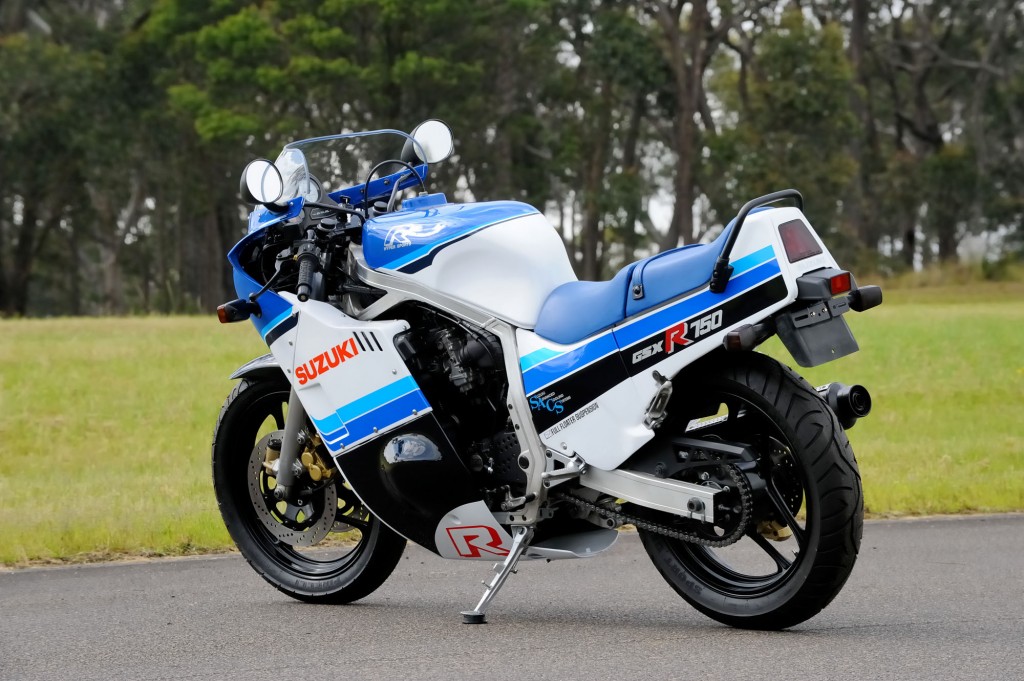
Yokouchi-San was a firm believer in pushing technology to improve the breed in an era when many Japanese engineers were being too conservative.
While the GSX-R was being developed, Suzuki released the RG250WE and GSX-R400. Both gave the public and the other big three Japanese manufacturers a preview of things to come from Suzuki.
Mr Yokouchi figured if the GSX-R400 could be made 18 per cent lighter than its competitors then the scale could be applied to the GSX-R750. The horsepower limit at the time was already an agreed voluntary restriction of 100hp so he knew that lightweight was the only way forward.
He had his engineers strip a GS750 and paint any parts that had not failed in the field red and any that had failed blue. When the parts were gathered together almost all of them red. “We were too conservative. Nothing ever broke. Everything was over-engineered”…
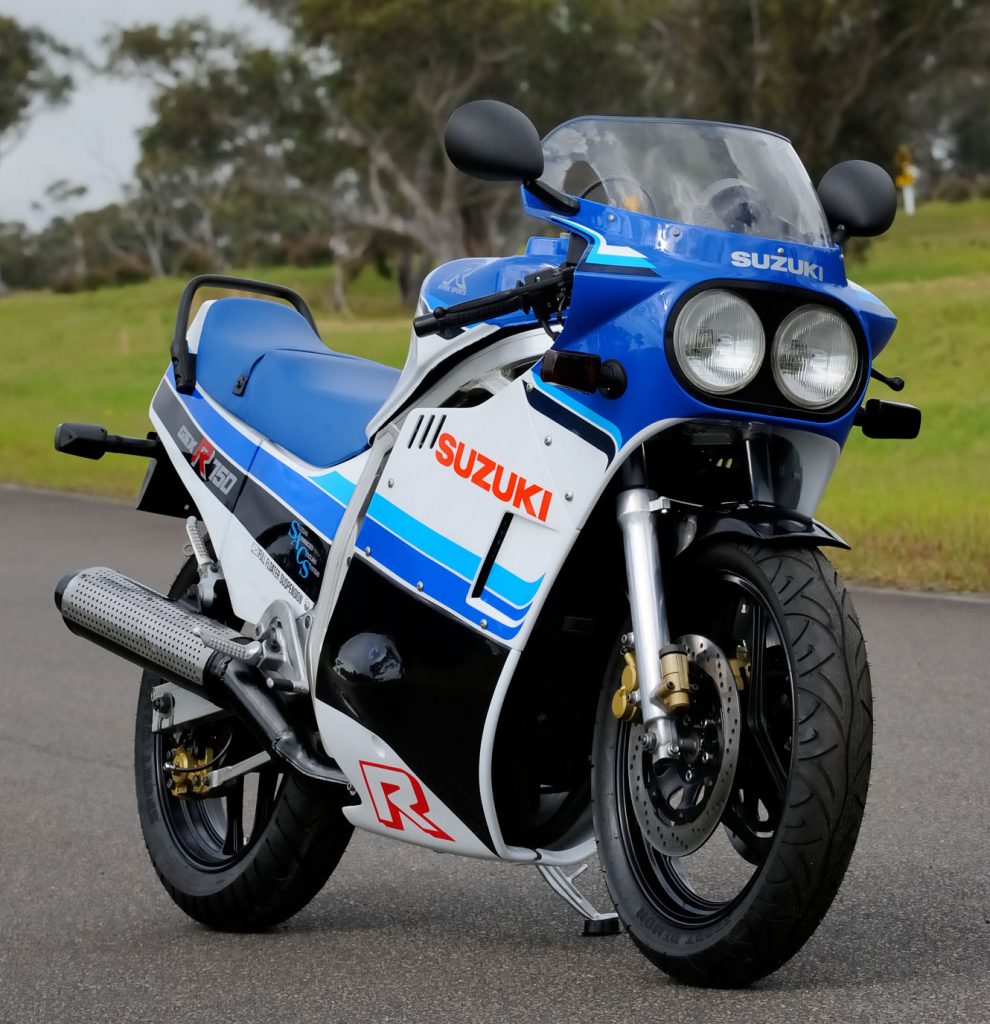
Jeff fully restored this GSX-R750F, the first of three he has done along with his RG500 and RG250HB.
He set the target at 20 per cent less than competitors 750s. 100hp and 176kg was the goal.
Chassis development began alongside engine development. Mr Yokouchi also insisted on using the racetrack dimensions. “What works on the racetrack will work on the street. The motorcycle does not know where it is being ridden”…
Using the 1983 Endurance World Championship winning HB Suzuki GS1000R ridden by Herve Moineau and Richard Hubin as a base to build the GSX-R from.
Styling was in the hands of the amazing Tetsumi Ishii who took as many angles from the GS1000R as possible. He did a brilliant job…
Since the release of the GSX-R750 in 1985 sportsbikes have gone full circle – lightweight, heavy, back to lightweight again but one thing is certain. Motorcycling performance can be split into two clear eras – before the GSX-R750F and after the GSX-R750F…
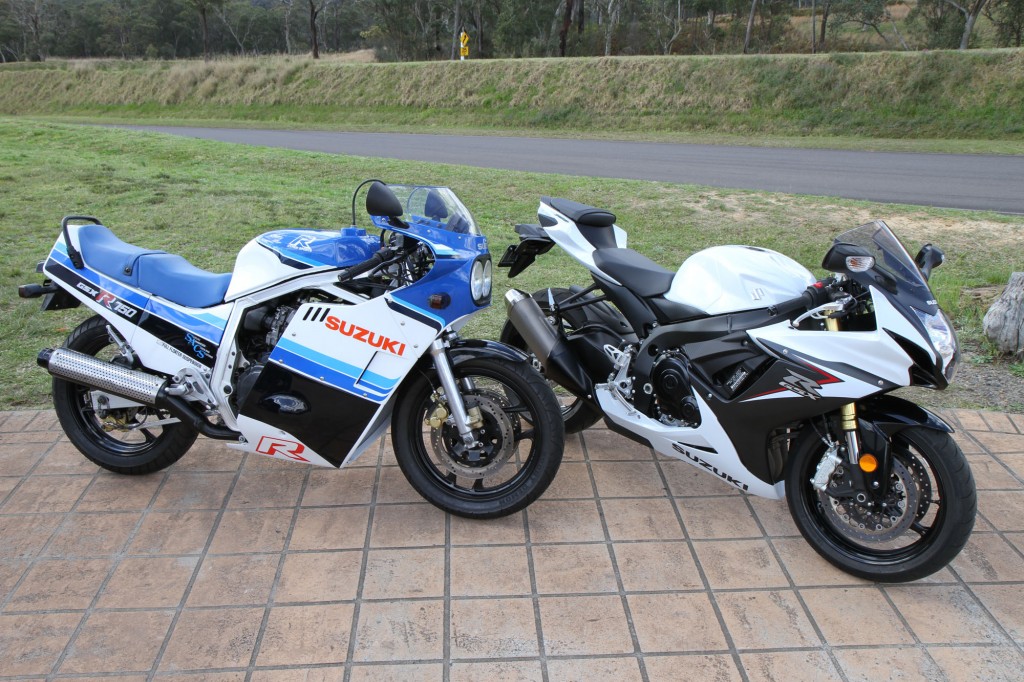
The GSX-R750’s looks may have developed over the years, but the lineage is clear and it’s still a fine looking machine.
35-years on and the GSX-R750F is still a stunning looking machine. In fact, I rate it as one of the best-looking motorcycles ever released. I may be biased, as I own the example you see on these pages, having bought it as a basket case and spending three years doing a full ground-up resto to get it back to as new. I ride the bike and I love it. It still holds it’s own and having owned RZs, and FZ750 and ridden many GPzs and VFs, I can tell you none come close to the handling and performance of the GSX-R750F for the era. Put it this way, I have nine bikes, some modern some older – the GSX-R750 is the lightest bike in my garage! On the scales, it is 10kg lighter than the new GSX-R750!
Don’t get me wrong – things have come a long, long way in 35-years and the old Slabbie would not even get close to catching the new 750 on the street or the track – but in terms of era, the ’85 bike must have blown the others into the weeds…
The engineers got that motor right – the fact that the new engine is the exact same bore and stroke or 70mm x 48.7mm proves that, despite a swing to a short stroke 73mm x 44.7mm engine for 1988 and 1989, the factory reverted to the 70mm x 48.7mm engine in 1990 and it has remained that ever since yet with modern cylinder-head technology, tuning, EFI and electronics it is now a whopping 50 per cent more powerful. Incredible.
So how would any red-blooded GSX-R750 fan celebrate the birthday of one of his all-time favourite bikes? That’s a no brainer, head to the world’s best proving ground and spend a day riding both bikes back-to-back.
RIDING THE OLD GIRL
Firstly, this is my first ride so I’m nervous. I’ve been restoring the bike for three-years and I’ve spent around $8000 on parts and thousand of hours in the shed. The bike has not turned a wheel for 20-years and aside from running through the gears on a stand…
Firstly, the old school feel of the bike is brilliant. The huge screen sits tall, the tank with endurance-style cap and vent is right under my chest, between my arms, making me feel like Graeme Crosby. The seat feels plush and so low; I’m in the bike not on it. It feels fantastic. The footpegs are hideously high and cramped feeling while the ‘bars seem really wide apart. I love the way the top triple-clamp sits tall above the traditional clip-ons. A real race feel from the 1980s.
The first thing I notice when I turn the key is… nothing! There is no fuel pump noise, there are no servomotors setting up, the dash doesn’t go through a series of epileptic fits. Nothing happens aside from the neutral light showing!
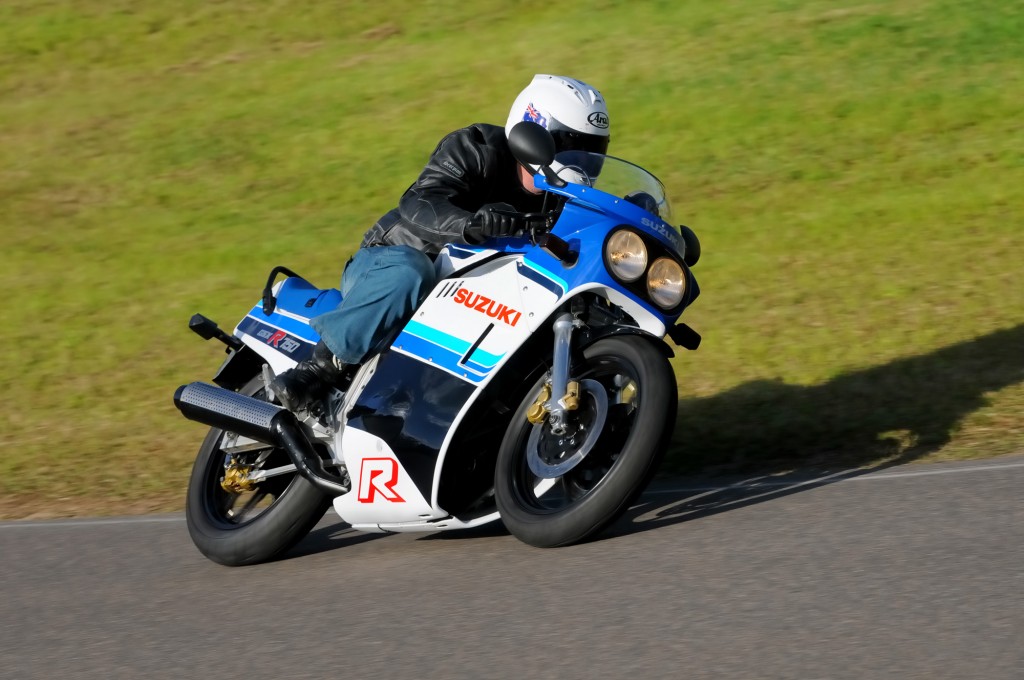
Jeff could not stop smiling after the ride in his 750F…
I turn the fuel tap on, pull out the choke (when was the last time you did that?) and hit the starter button. She fires into life and rumbles away, the smell of rich unburned fuel sticking to me as it richly warms up on the choke. Warming up seems to take forever, not like these days when bikes idle instantly and off you go…
I select first gear and head out for my first ever ride. It’s a moment I won’t forget in a hurry – riding my pride and joy for the first time. It was everything and more that I imagined it would be and I felt an incredible sense of achievement as I cruised around. After a few laps to scrub tyres, bed brakes, make sure there are no fuel or oil leaks etc, I do a proper test and ride the bike as fast as I can.

The Pirelli Sport Demons are a fantastic tyre for your retro machine.
The immediate thing I notice is just how gloriously smooth this engine is. Suzuki nailed it and it is silky smooth with a fabulous gearbox. Clutch action is also fantastic and the carburetion, although touchy thanks to the flatslides, is pretty good on my rejetted bike.
The howl from the standard exhaust system is invigorating and the bike has the same spine-tingling sound as the new 750, without the induction roar…
Acceleration is nowhere near the new bike. Top speed runs out at around 90km/h in first gear, 120km/h in second, 155km/h in third and I just nudged 190km/h in fourth at the same spot the 2015 model was doing 220km/h so that is a full 30km/h down on top speed, with a similar run onto the actual straight!
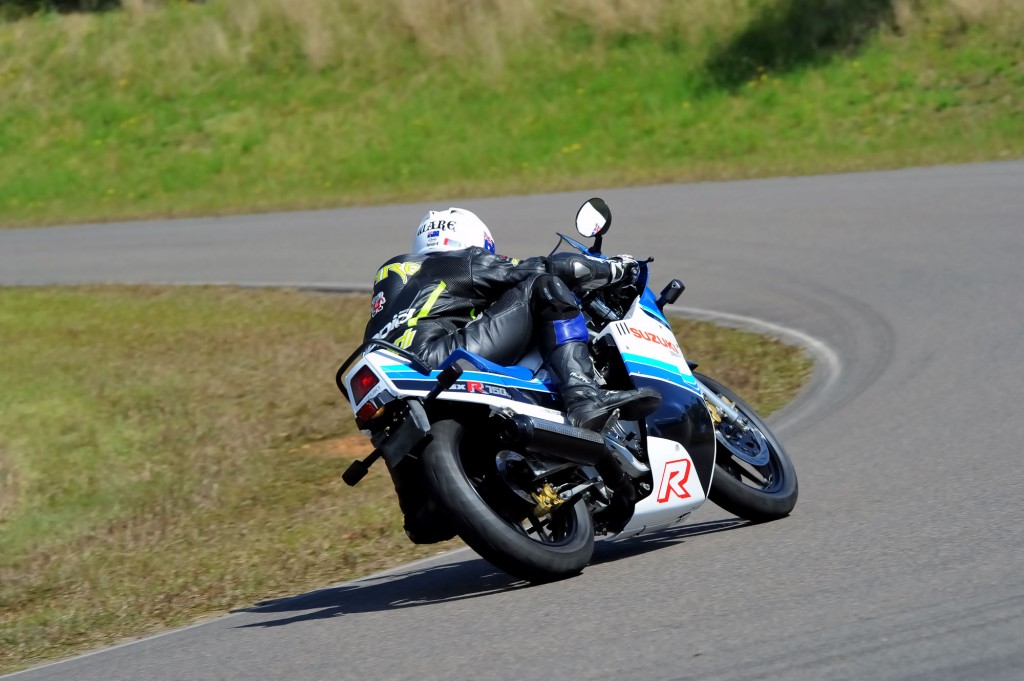
Jeff runs a Zenodamper R6 custom shock and modern fork internals as well as Venhill lines and race pads.
I have to admit I’ve had modern springs and emulators fitted to the forks, while the shock is a modified R6 shock, so the suspension is brilliant! Braking also – I’m cheating, with Venhill brake lines and Bendix brake pads there is some improvement there over stock brakes but nothing on the new machines.
Cornering has to be done old school, with lots of braking a little earlier then fast sweeping lines through the turns. With the narrow tyres (Pirelli Sport Demons) providing sensational cornering speed and the lightweight narrow rims mean steering is faster than I thought it would be for big 18in wheels.
However, in terms of being maneuverable or raceable, the new 750 would run rings around the ‘one-line’ GSX-R750F. I found tucking in low and not hanging off too much felt the most comfortable.
Overall, mind blowing for a 35-year old bike but it needs to be ridden with finesse and patience whereas the new bike can be ridden in anger.
Out on the street, my 1985 GSX-R is an incredibly good roadbike aside from the cramping footpeg position. Amazingly, it runs at a good temperature all the time – Yokouchi-San did an amazing job with the oil cooling. Incidentally, he thanks his grandmother for teaching him to stir the bathwater. He was lazy and the old bath with a fire underneath it had to have the water circulated to avoid hot spots. He applied this principle to keeping the oil flowing around the combustion chamber of the GSX-R750F!
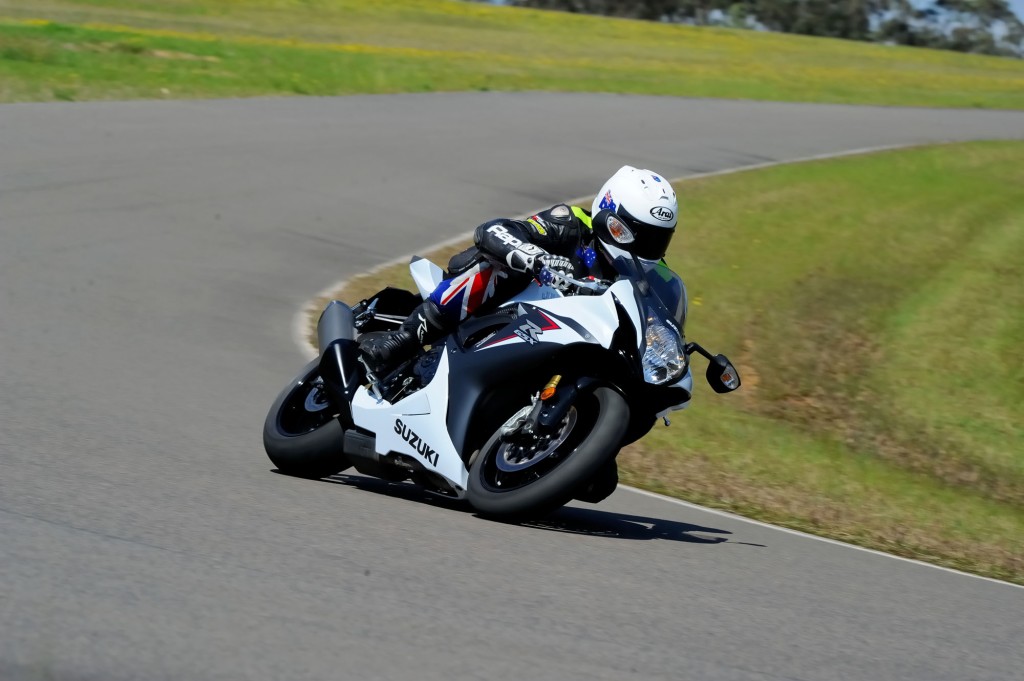
ON THE 2015 GSX-R750
First impressions? The bike still has that GSX-R750 heritage we all love. The stacked headlights don’t do it for me and never have on any bike but I like the new bodywork and definitely the muffler. Sitting on the bike, the tank feels comfy for my tall frame and there is an overall feeling that the bike is very low and narrow due to the flat tank top and seat plus the narrow seat rails.
Like all GSX-R750s right back to the 1985, the footpegs are high and uncomfortable. For me, they need to be on the lowest setting but even then they feel too high… I do feel I’m sitting way closer to the ‘bars than on my 1985 model.
Firing the bike up, it has that traditional intake growl and sharp rumble from the muffler. Sounds much the same as the previous generations, a good thing. Heading out pit lane I short shift through the gearbox and the ratios feel a bit wide, it could do with the closer ratios in the 600cc engine. The engine pulls hard and the intake growl is awesome.
Acceleration is so much quicker than the F model but it’s the first braking area that I really notice – the Brembo brakes initial bite is good and the feel is incredible 35-years on. And turn-in on the new bike is rapid and light, with the riding position making me feel comfortable, confident and in control from the off – something that was not the case on my old bike…
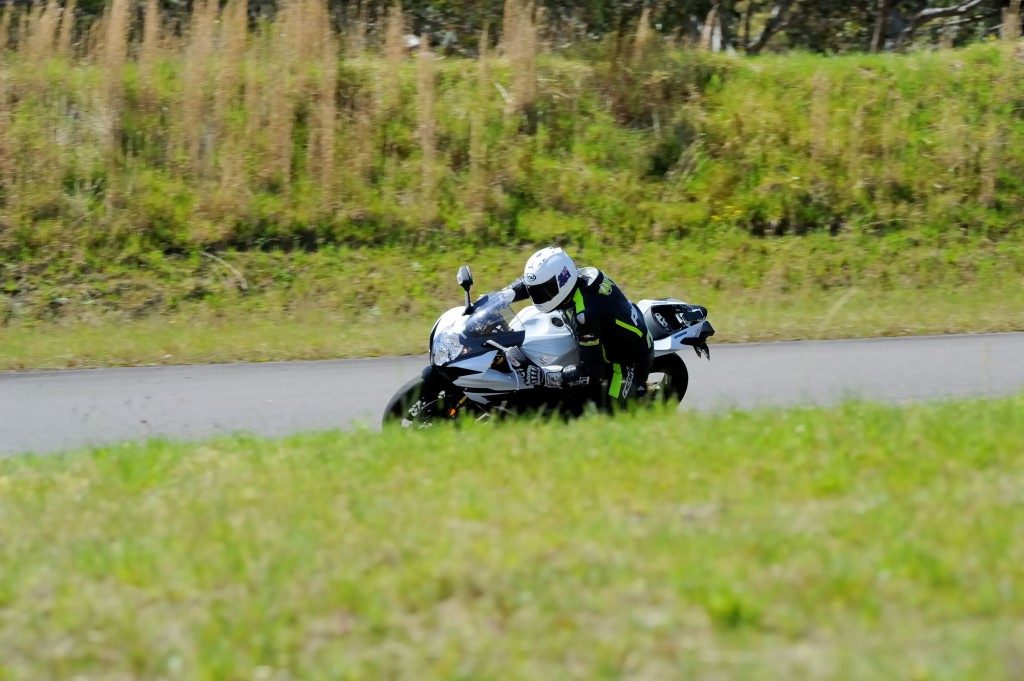
The GSX-R750 is one of the top sportsbike on the market to this day and often overlooked in pursuit of power.
The acceleration is strong and I reach a top speed of 220km/h each lap and that is in fourth gear. Braking hard from that speed to enter the third-gear turn at the end of the back chute, the new bike feels great, where the old bike wallows. There is not much stand-up on the brakes hard into the turn (lots of trail braking) and the steering remains light and accurate even under brakes.
There’s a very neutral and controllable, almost effortless, transition from upright to full lean with no sudden fall-in. The bike just rolls onto its side gracefully and holds a tight line with no unsettled behaviour over any of the bumps. It’s hard to believe this is a 750. It’s got to be smaller than an RGV250! And is so much smaller than the Slabbie!
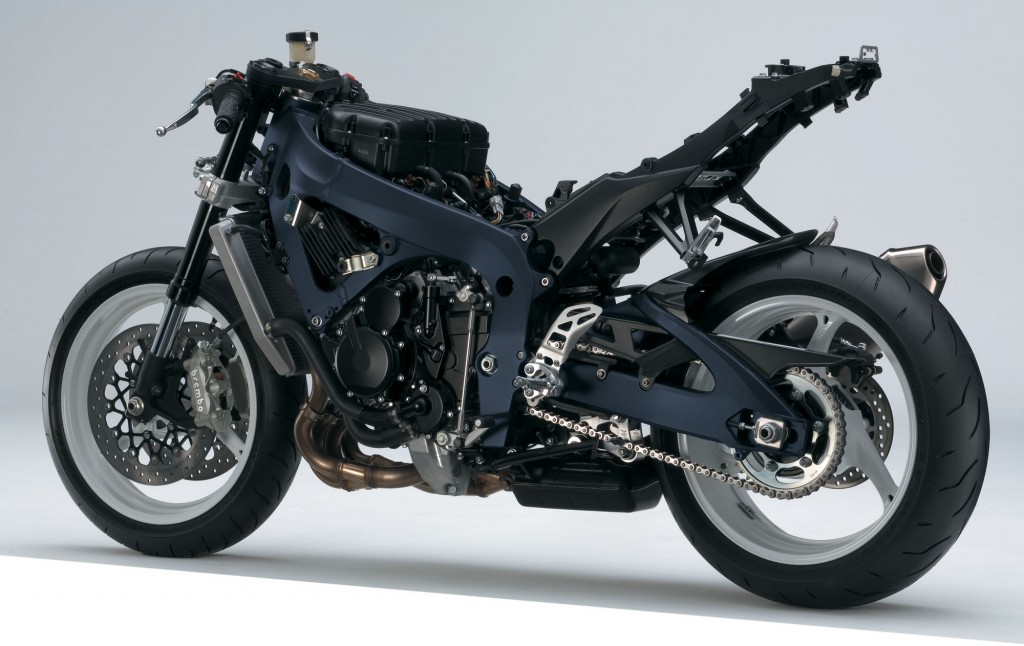 Whether it’s accelerating through long turns, braking into hairpins, or changing direction fast, the GSX-R750 remains very responsive and easy to ride. Suzuki engineers have got the geometry very well sorted and this is really highlighted by the performance of the suspension.
Whether it’s accelerating through long turns, braking into hairpins, or changing direction fast, the GSX-R750 remains very responsive and easy to ride. Suzuki engineers have got the geometry very well sorted and this is really highlighted by the performance of the suspension.
The Big Piston Forks are fantastic. Under very hard braking they keep the bike stable and off the brakes into a corner they settled very quickly. The rear shock is not quite up to the same level as the forks, giving some rear end instability and kicking back over some of the harsher bumps during the road riding but not on the smooth surface.
Overall an incredible bike that is a razor sharp race tool. On the other hand the 750F feels every bit of the 35-years older but really has some special feel about it that makes it a more engaging and fun ride than the 2015 model. It’s more raw, more direct and unique and less clinical…
Next we test the mighty GSX-R750M, followed by the first injected 750. In the meantime check out our 1996 GSX-R750 test here.
2015 Suzuki GSX-R750
Claimed power: 110.3kW[146hp]@13,200rpm
Claimed torque: 86.3Nm[63.6ft-lbs]@11,200rpm
Wet weight: 190kg
Fuel capacity: 17L
Engine: Inline four-cylinder, four-stroke, liquid-cooled, DOHC
Bore x stroke: 70 x 48.7mm
Displacement: 749cc
Compression ratio: 12.5:1
Fuel delivery & Ignition: SDTV 8-injector EFI with SDMS, new ECM and transistorised ICU
Exhaust: Four-into-one stainless steel/Titanium Euro3
Gearbox: Six-speed close-ratio cassette-style
Clutch: Wet, multiple-plate slipper
Final drive: 530 O’ring chain
Frame type: Twin spar aluminium
Wheelbase: 1390mm
Rake: 23.45
Trail: 97mm
Front suspension: Showa Big Piston Forks, four-way adjustable, 120mm travel
Rear suspension: Showa Link type four-way adjustable, 130mm travel
Front brake: Dual 310mm floating stainless-steel rotors, Brembo four-piston 32mm radial-mount calipers, Nissin 17.46mm master-cylinder
Rear brake: Single 220mm stainless-steel rotor, Nissin single piston 30.23mm caliper, Nissin 14mm master-cylinder
Wheels: Cast aluminium, 17in
Tyres: 120/70 – 17in, 180/55-17in
Ground clearance: 130mm
Seat height: 810mm
Overall height: 1135mm
Overall length: 2030mm
Instruments: Analogue tacho, digital speedo, dual trip meters, reserve trip, clock, coolant temp, oil pressure, lap timer, S-DMS indicator, gear position indicator, five stage shift light
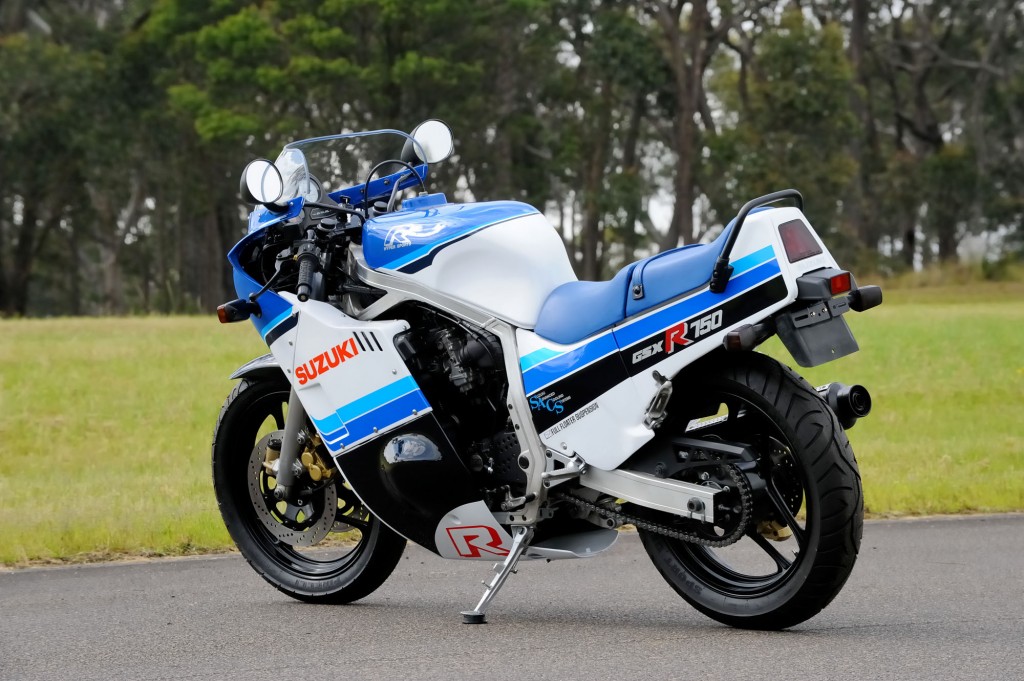
1985 Suzuki GSX-R750F
Claimed power: 75kW[100hp]@10,500rpm
Claimed torque: 68Nm[52ft-lbs]@8000rpm
Dry weight: 176kg
Fuel capacity: 18.5L
Engine: Inline four-cylinder, four-stroke, oil-cooled, DOHC
Bore x stroke: 70.0 x 48.7mm
Displacement: 749cc
Compression ratio: 9.8:1
Fuel delivery & Ignition: VM29SS flat-sides, transistor ignition
Exhaust: Four-into-one steel
Gearbox: Six-speed close-ratio
Clutch: Wet, multiple-plate, hydraulic actuation
Final drive: 530 O-ring chain
Frame type: Aluminium cradle, alloy box-section swingarm
Wheelbase: 1425mm
Rake: 26
Trail: 107mm
Front suspension: Posi Damp Fork, adjustable compression damping and spring preload, conventional 41mm, 130mm travel
Rear suspension: Full Floater, rebound and spring preload adjustment, 127mm travel
Front brake: Dual 300mm stainless-steel rotors, four-piston calipers
Rear brake: Single 220mm stainless-steel rotor, two-piston caliper
Wheels: Cast aluminium, 18in
Tyres: 110/80 – 18, 140/70 – 18
Ground clearance: 140mm
Seat height: 755mm
Overall height: 120mm
Overall length: 2130mm
Instruments: Analogue tacho and speedo, couple of idiot lights.


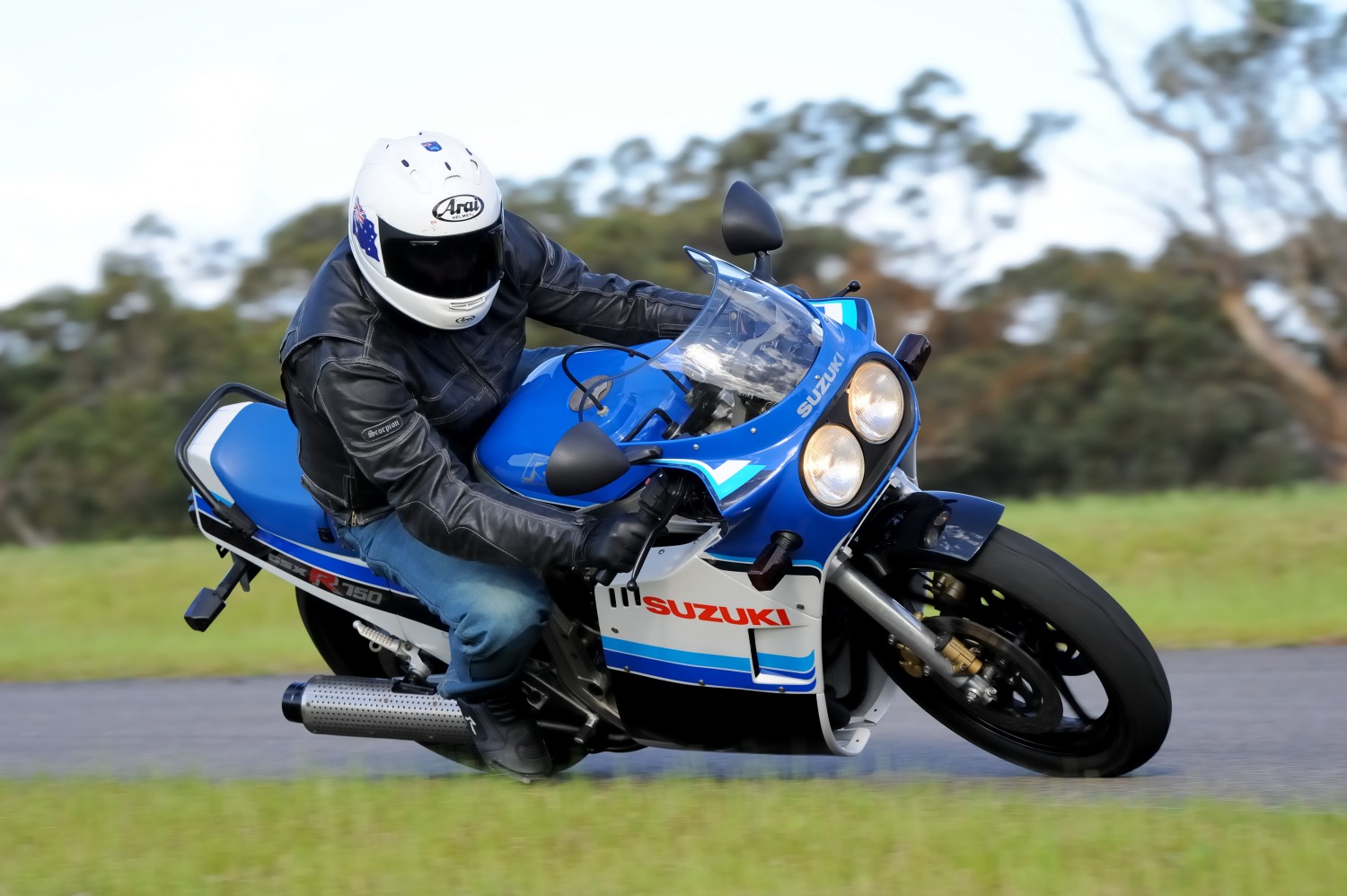
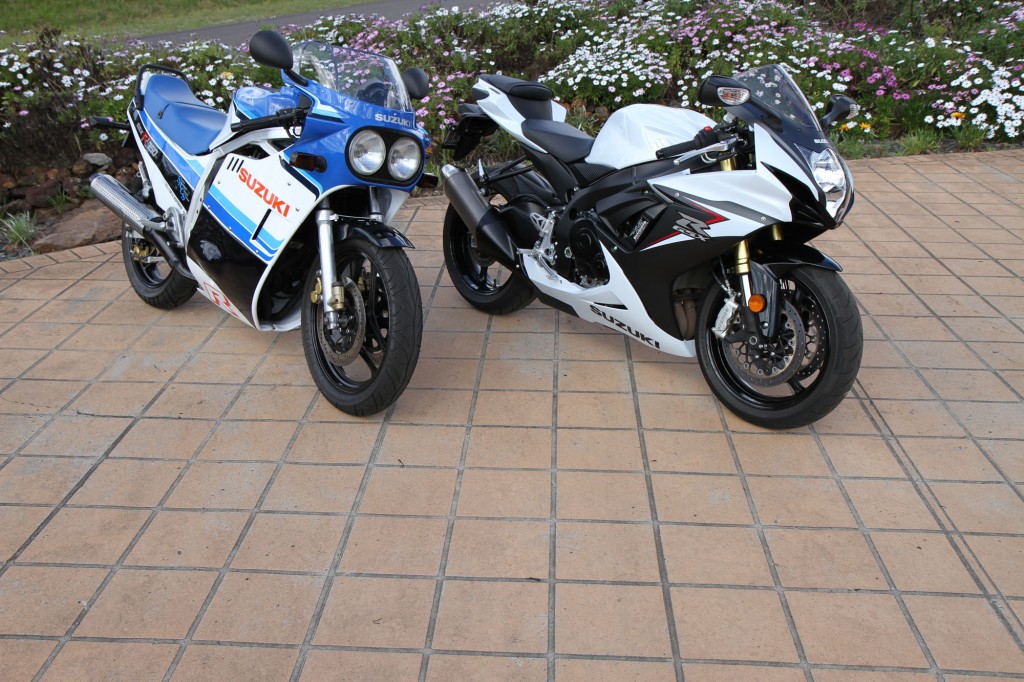
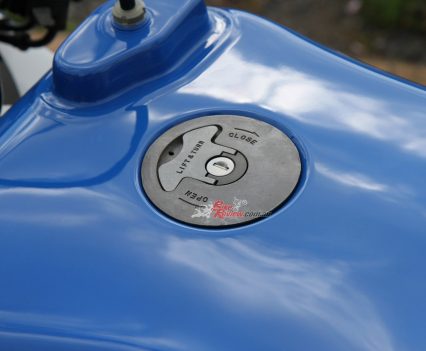
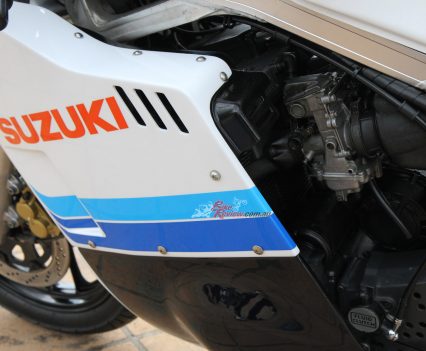
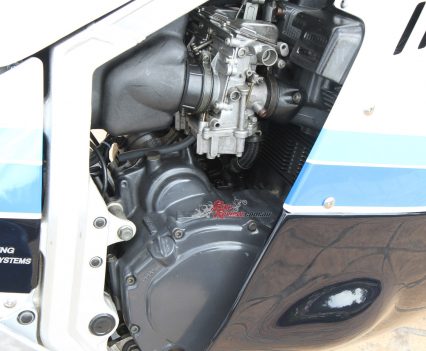




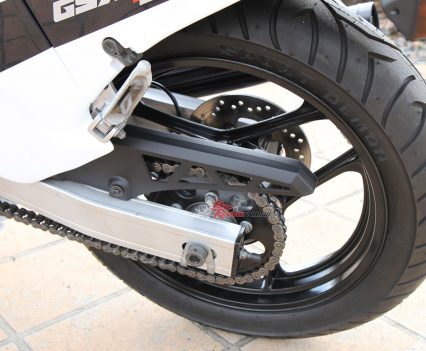
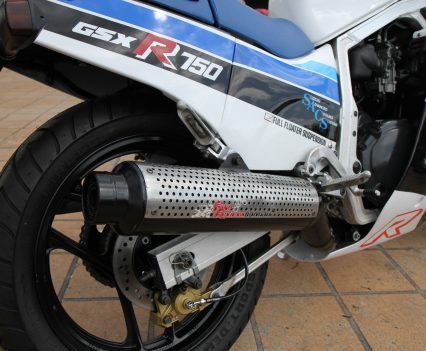

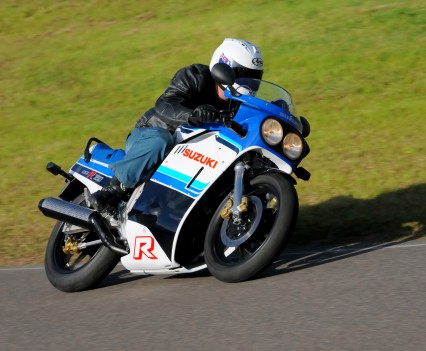
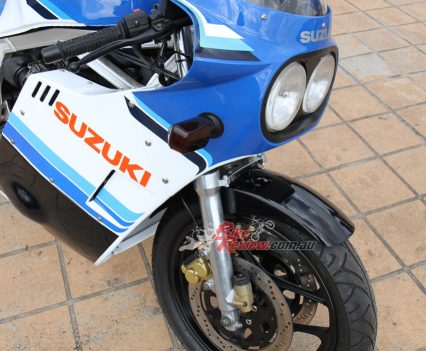
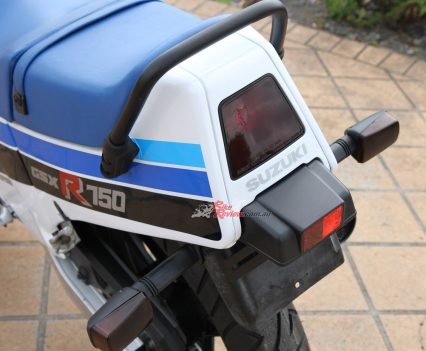
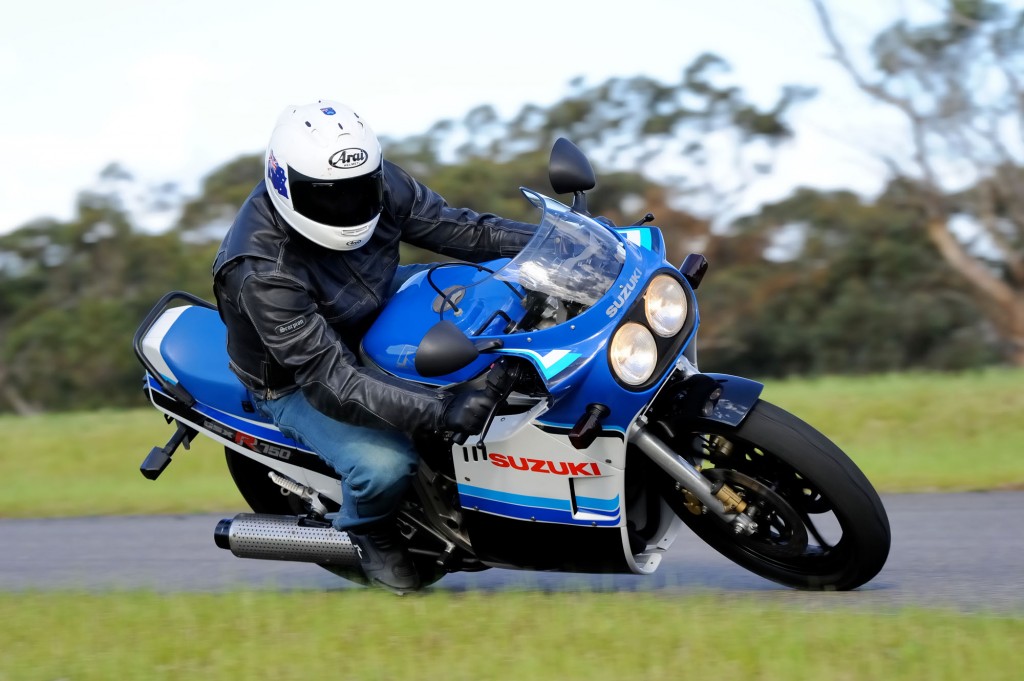

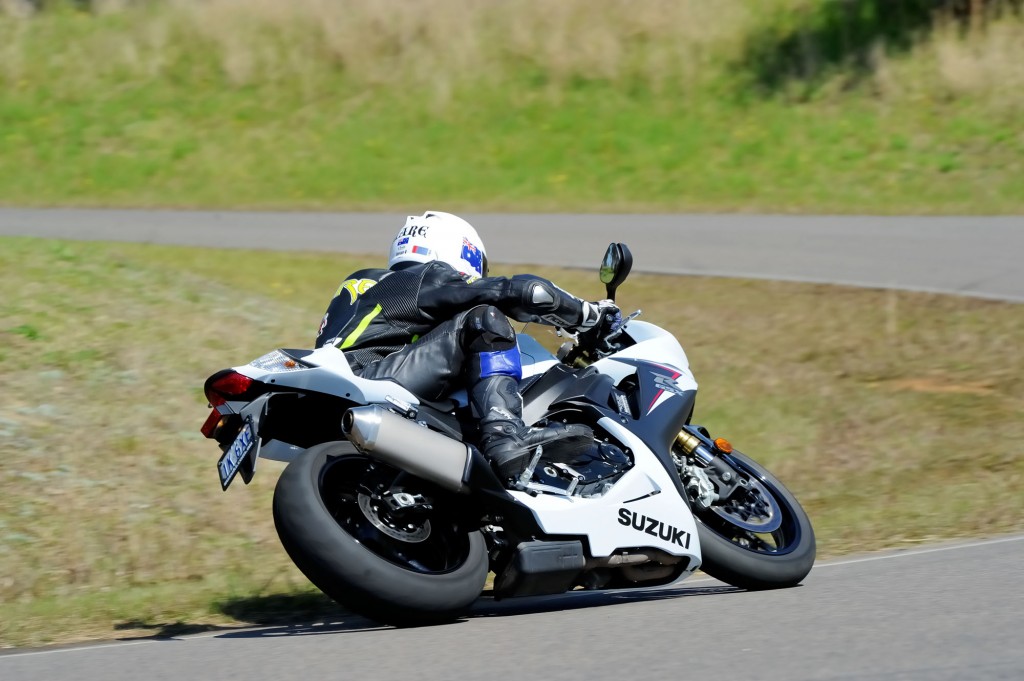

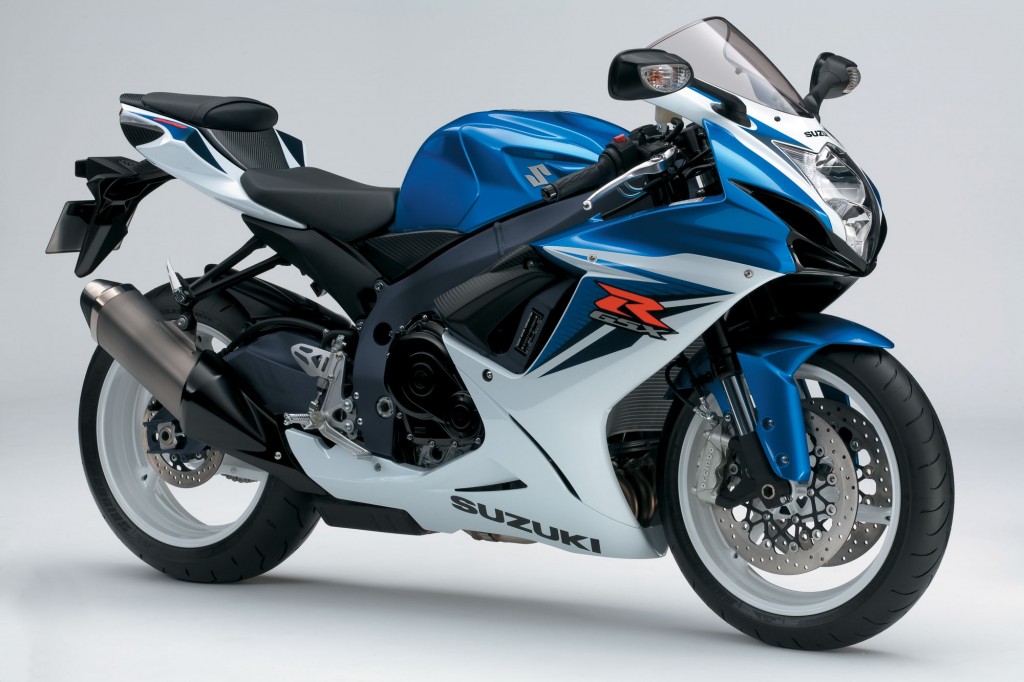


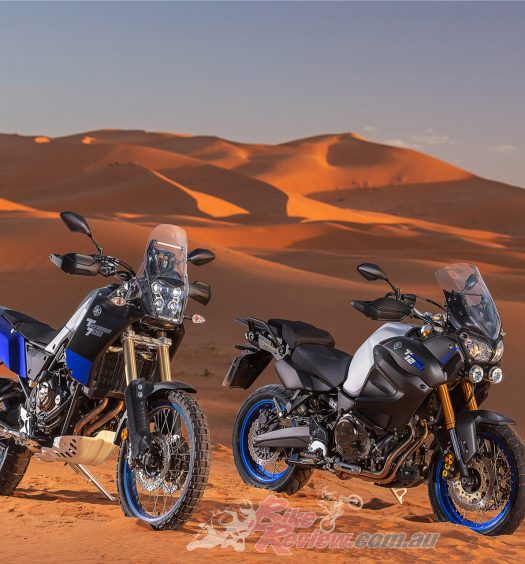


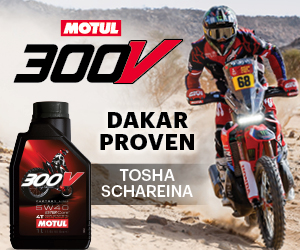
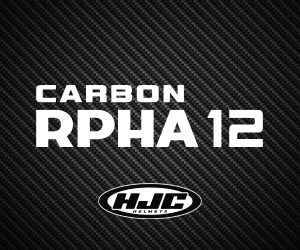
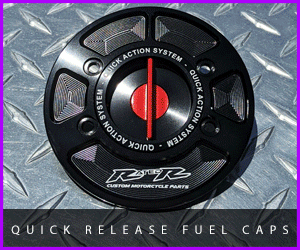

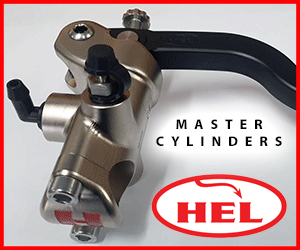







September 4, 2017
In January of 1986 I traded in my 86 Honda XL250R. It was a kickstart dual purpose Bike. I saw a 1986 blue and white GSXR750 in the showroom. It had a gouge in the front fender and they replaced it after I bought it a couple weeks later. It was a Racebike with lights.
I took off the rear pegs. Kept the white cover with blue backrest on the passenger seat. Took off the rear passenger grab rail. Had the gas tank painted Blue with Silver tipped darker blue flames. Put a Lockhart tinted screen on and a clear plastic cover over the two head lamps.Put a full system Yoshimura pipe on it. The high pegs and clip on low handle bars killed my back.
I drove that motorcycle all over. Never got a ticket or had a accident. I would ride it 70MPH to 110MPH all over the freeway and canyon roads. It was the best bike for tight Topanga Canyon. I passed so many cars. Had one flaw and that was the front brakes. I would whip around cars and put on the front brakes before going into a 180 degree down hill turn.
The brakes at first wouldn’t catch and than all of a sudden the brakes would kick in and slow me right down. It was just initially when you grabbed for them they took a moment to work. I was able to go a top speed of 128MPH on that bike.
It needed Metzler tires so the tires didn’t follow the freeway rain grooves. It came with 18 inch front and rear radial tires. I think the first Radial tires on a production Sportbike. It was so light and had a tight wheelbase and on a smooth paved road it was the best!!!
One other thing is sometimes I would get a false neutral in between gears and I would have to slow down and pull in the clutch and when I was going slower kick it down one gear or it would slide the rear wheel. It had a really smooth easy to change gears 6 speed gearbox.
In January of 1987, the one day I didn’t use my Kryptonite Lock at work it was stolen. I was bummed out as I could only afford a 1987 Kawasaki Ninja 600R. Hated that bike. Traded it in for a 1988 Kawasaki Ninja 750R. I had that bike for 12 plus years.
I put a 130,000 plus miles on that motorcycle. Than I didn’t have a bike for almost ten years. I bought a 2009 Yamaha FZ6 in 2010. My favorite motorcycle thus far. I had to sell it in 9/2013 as my father was in Hospice and passed in 10/2013. I needed to make ends meet. I have been without a Bike now for 4 years. I’m going crazy. They are so expensive today. I hope I can get another Motorcycle before this year is over.
September 7, 2017
Hey Johnny sounds like you had some great times on your GSX-R750, sad to hear you don’t have a motorcycle now. I had an FZ6 in white (2008 model) for a number of years and they were a great machine, I always wanted the earlier orange colour scheme with black stripe though.
Going for a ride is a great release/relax, so good luck getting back on two wheels, let us know how you go!
July 23, 2020
Johnny Nightrider, save your money and buy yourself an old Slabby as i have. It’s better to ride than the new bikes and is an investment for the future.
Mine GSX-R 750F 1985.